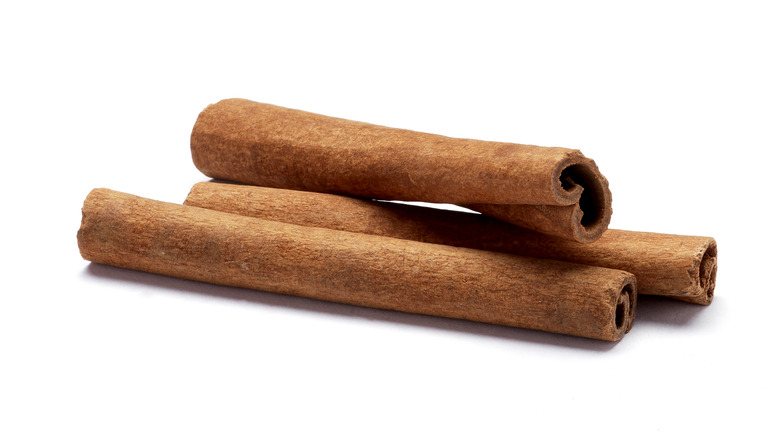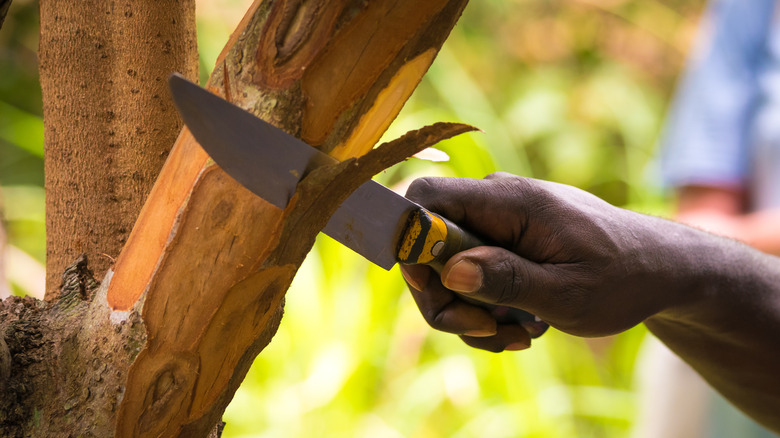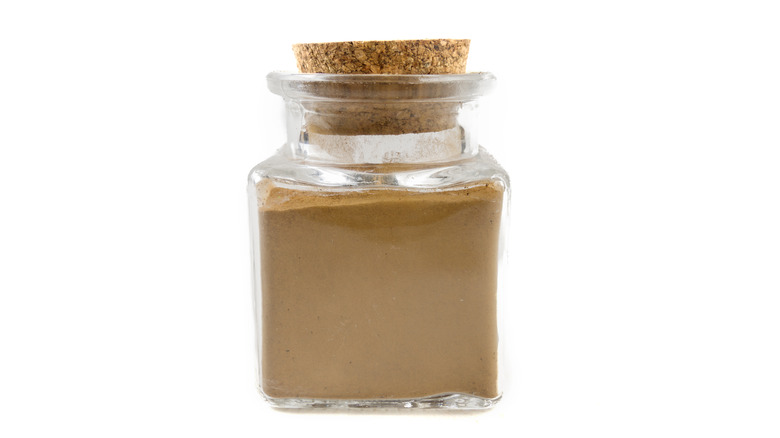What's Actually In Imitation Cinnamon
Even if you haven't heard of imitation cinnamon, chances are very high that you've eaten it, especially if you've ever bought cinnamon from a grocery store. That's because there are two main types of cinnamon.
First is the "true" stuff from the Cinnamomum verum tree, which grows primarily in Sri Lanka and southern India. It's sometimes called Ceylon cinnamon, referring to Sri Lanka's colonial name. Then there's cinnamon from the Cinnamomum cassia tree, sometimes called cassia or "Chinese cinnamon," which grows more widely across eastern and southeastern Asia. Cassia is typically what you'll get when you buy cinnamon in the supermarket, as it's more common — and far cheaper — than Ceylon cinnamon.
Somewhat surprisingly, cassia cinnamon is generally more intense-tasting than Ceylon because the oils in the cassia plant contain a higher proportion of cinnamaldehyde, a flavonoid (more or less a flavored pigment). It's not even close: Cassia oil is over 90% cinnamaldehyde, compared to about 50 to 60% in Ceylon. Cinnamaldehyde lends a sharp, spicy taste to cinnamon and is part of the reason it's so painful to eat a spoonful of cinnamon, especially if it's the cassia variety. The more modest cinnamaldehyde levels are why Ceylon cinnamon is prized –– it's seen as more delicate, nuanced, and refined than the hardcore cassia variety.
Other differences between Ceylon and cassia cinnamon
For culinary purposes, the varying cinnamaldehyde levels between "real" Ceylon cinnamon and "imitation" cassia cinnamon is the primary difference you should understand. However, there are more differences to note. First, cassia cinnamon grows far more widely than Ceylon and is easier to cultivate, which is why it's cheaper. While both varieties come from the bark of their respective trees (which gets stripped and rolled up into sticks or ground up), cassia is typically a darker shade of brown. If you're getting it as a stick, cassia will also have a rougher texture and thicker layers of bark. If you're buying ground cinnamon, cassia is known to be padded with fillers like almond shells, so that's one argument in favor of buying sticks instead of the powdered version.
There are also different varieties of cassia cinnamon: The Indonesian version tends to be milder (and is more common in the United States); Saigon or Vietnamese cassia has a more intense scent and taste.
Is cassia really fake cinnamon?
Although cassia cinnamon sometimes pretends to be the "genuine" Ceylon variety, it might be an exaggeration to say that it's completely "fake" cinnamon. In reality, the difference is more nuanced than vanilla, for example, where "real" vanilla comes from beans and "imitation" vanilla was more or less created in a laboratory.
Cassia cinnamon plants are within the same family as Ceylon, so, scientifically speaking, it's still unambiguously a type of cinnamon. However, it's considered lower quality — a little like the difference between good arabica coffee beans and their rough-edged robusta cousins.
However, if you're dedicated to getting the best cinnamon on the market, you'll probably still want to try to find the Ceylon type. This may be easier said than done: The FDA allows cassia and Ceylon to be labeled as "cinnamon" without indicating the exact variety. You'll want to look for "Ceylon" as a descriptor, but if you want to be extra sure, consider going to a specialty spice shop and asking for the good stuff.


